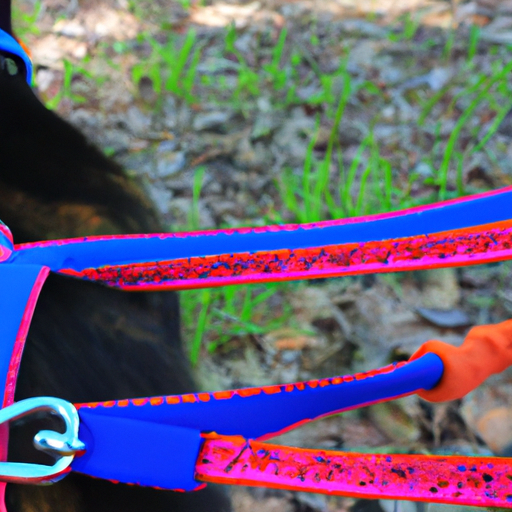Have you ever thought about taking your cat for a walk? It might seem like an unusual idea, but with the right training and precautions, walking your feline friend on a leash can be a safe and enjoyable experience for both of you. In this article, we will explore the world of cat leash training and provide you with tips and techniques to help you embark on this exciting adventure with your fluffy companion. Whether you have a curious kitten or an adult cat, these guidelines will help you create a bond and provide mental and physical stimulation for your feline friend. So grab a leash, buckle up, and get ready to explore the great outdoors with your whiskered buddy!
Understanding the Benefits of Cat Leash Training
Cat leash training is a practice that involves teaching your feline friend to walk on a leash. While cats are often associated with freedom and independence, leash training can offer numerous benefits for both cats and their owners.
Promotes Exercise and Mental Stimulation
One of the primary benefits of cat leash training is the promotion of exercise and mental stimulation. Many cats lead largely sedentary indoor lives, which can lead to weight gain, boredom, and behavioral issues. By taking your cat for regular walks, you provide them with an opportunity to expend energy, explore their surroundings, and engage their curious nature.
Walking on a leash encourages cats to use their muscles, stretch, and engage in physical activity. It can also offer mental stimulation as they encounter new smells, sights, and sounds outside of their usual indoor environment. This mental stimulation is essential for preventing boredom and can contribute to the overall well-being of your furry companion.
Enhances Bonding Between Owner and Cat
Another significant benefit of cat leash training is the enhancement of the bond between you and your feline friend. Walking together allows for quality time spent with your cat, strengthening the emotional connection between you. It creates an opportunity for shared experiences and adventures that can foster a deeper sense of trust and understanding.
Leash training also provides an opportunity for socialization, allowing your cat to interact with other animals and people in a controlled environment. This exposure can help them become more comfortable and confident in different situations, making them more adaptable and sociable overall.
Helps Prevent Obesity and Health Issues
Obesity is a common concern among indoor cats, often resulting from a lack of physical activity and overeating. Cat leash training can be an effective tool in preventing obesity and related health issues. By encouraging exercise through regular walks, you help your cat burn calories and maintain a healthy weight.
Additionally, leash training can contribute to the overall health and longevity of your feline friend. Regular exercise helps keep their muscles toned, joints flexible, and cardiovascular system in good condition. It can also reduce the risk of developing common health issues such as diabetes, heart disease, and arthritis.
Choosing the Right Leash and Harness
Before embarking on cat leash training, it is essential to select the appropriate leash and harness that ensures comfort, safety, and adjustability for your cat.
Opting for a Lightweight and Adjustable Leash
When choosing a leash, opt for one that is lightweight and made of a comfortable material such as nylon or cotton. This will prevent it from weighing your cat down or causing discomfort during walks. A retractable leash can be beneficial as it allows for varying lengths and offers more freedom for your cat to explore their surroundings while still maintaining control.
Ensure the leash is of an appropriate length for your cat’s size and agility. A shorter leash may be more suitable for smaller or less active cats, while a longer leash can accommodate larger or more energetic breeds.
Considering a Harness Instead of a Collar
Unlike dogs, cats have delicate necks that can be easily injured if they pull or become entangled in a traditional collar. Instead of using a collar, consider using a harness specifically designed for cats. A harness distributes pressure more evenly across your cat’s body, reducing the risk of injury.
Look for a harness with adjustable straps to ensure a proper fit. It should be snug enough that your cat cannot slip out of it but loose enough to allow for comfortable movement.
Ensuring Proper Fit and Comfort
Regardless of whether you choose a leash or harness, it is crucial to ensure a proper fit and comfort for your cat. Check that the leash or harness does not cause any chafing or irritation, and regularly inspect it for wear and tear. If your cat seems uncomfortable or displays any signs of distress, consider trying a different type or adjusting the fit accordingly. Remember, your cat’s comfort and safety should always be a priority.
Preparing Your Cat for Leash Training
Before you start outdoor walks, you need to prepare your cat for leash training by gradually introducing them to the harness, leash, and the concept of walking on a leash.
Getting Your Cat Used to a Harness
Some cats may initially find wearing a harness unfamiliar or uncomfortable. To help them adjust, start by placing the harness near your cat’s resting area, allowing them to investigate and become familiar with its scent and presence. Gradually introduce the harness by placing it on your cat for short periods while offering praise and treats.
If your cat shows signs of distress or resistance, be patient and allow them to acclimatize at their own pace. Never force your cat into wearing a harness as this can create negative associations and hinder progress.
Introducing the Leash and Harness Gradually
Once your cat is comfortable wearing the harness, attach the leash to it and allow them to walk around the house under close supervision. Start with short sessions and gradually increase the duration as your cat becomes more accustomed to the sensation of being tethered.
During these initial training sessions, it is important to remain calm and avoid any sudden movements or loud noises that may startle your cat. Make the experience positive by offering praise, treats, and gentle encouragement whenever they display calm behavior or explore the environment willingly.
Using Positive Reinforcement and Rewards
Positive reinforcement is a key component of cat leash training. Whenever your cat successfully walks on a leash without resistance or fear, reward them with treats, verbal praise, or a gentle petting session. This positive association will encourage them to repeat the behavior and associate the leash and harness with positive experiences.
Avoid using punishment or negative reinforcement, as this can create anxiety and hinder the training process. Cat leash training relies on building trust and confidence, so maintaining a positive and encouraging environment is essential for success.
Creating a Safe and Controlled Environment
When taking your cat outdoors for leash training, it is crucial to create a safe and controlled environment that minimizes potential risks and dangers.
Choosing a Quiet and Familiar Outdoor Area
When selecting an outdoor area for leash training, choose a quiet and familiar location that is free from excessive noise, traffic, and other potential stressors. This will help your cat feel more comfortable and prevent unnecessary distractions during training sessions.
Start with a small area, such as your backyard or a secluded park, and gradually expand to more stimulating environments as your cat becomes more confident and accustomed to the leash.
Ensuring the Area is Free from Potential Dangers
Before starting any training session, thoroughly inspect the area for potential hazards that could harm or startle your cat. Remove any toxic plants, sharp objects, or small items that your cat may be tempted to investigate or potentially ingest. Also, ensure that the area is free from other animals that may pose a threat to your cat’s safety.
Inspect fences or enclosures to ensure they are secure and do not provide opportunities for your cat to escape. Creating a safe and controlled environment is essential for successful leash training and the overall well-being of your cat.
Using a Secure and Sturdy Leash Connection
Check the connection between the leash and the harness or collar to ensure it is secure and sturdy. It should be strong enough to withstand your cat’s movements while still allowing them to move naturally. Regularly inspect the leash for any signs of wear or damage and replace it if necessary.
Avoid using retractable leashes near roads or other potential hazards, as your cat may get too far away from you before you can react. Opt for a leash length that provides an appropriate balance of freedom and control, ensuring the safety of both you and your feline companion.
Teaching Basic Commands and Behaviors
In addition to leash training, it is beneficial to teach your cat basic commands and behaviors that will further enhance the walking experience and ensure their safety.
Introducing Commands such as ‘Sit’ and ‘Stay’
Teaching your cat basic commands like ‘sit’ and ‘stay’ can help maintain control and ensure their safety during walks. Start by practicing these commands indoors in a quiet and familiar environment. Use treats and positive reinforcement to reward your cat when they successfully perform the desired behavior.
Gradually introduce these commands during outdoor training sessions, ensuring your cat understands and follows them even with distractions present. Consistency is key, so continue incorporating these commands into daily walks to reinforce good behavior.
Training Your Cat to Walk Calmly on a Leash
Training your cat to walk calmly on a leash requires patience and consistency. Start by allowing them to lead the way initially, following their pace and direction. However, gradually encourage them to walk alongside you by gently guiding them with slight leash pressure.
Avoid pulling on the leash or forcing your cat to walk faster than they are comfortable with. Instead, use gentle tugs or direction changes to guide them. Reward them with treats and praise when they walk calmly without resistance, reinforcing the desired behavior.
Rewarding Desired Behaviors and Ignoring Unwanted Ones
During training sessions, it is important to reward your cat for displaying the desired behaviors, such as walking calmly, not pulling on the leash, or responding to basic commands. Offer treats, praises, or pets as a means of positive reinforcement. This rewards-based approach encourages your cat to repeat these behaviors in the future.
However, if your cat displays unwanted behaviors such as excessive pulling or resisting the leash, it is essential to remain calm and avoid reacting strongly. Instead, ignore these behaviors and wait for them to settle down before continuing the walk. Consistency and patience are key elements in effectively training your cat to walk calmly on a leash.
Practicing Patience and Consistency
Cat leash training is a process that requires patience, consistency, and understanding. It is essential to approach the training sessions with a calm and positive attitude, as cats are sensitive to their owner’s emotions and reactions.
Understanding that Cat Leash Training Takes Time
Every cat is unique, and the time it takes for them to become comfortable and proficient in leash training can vary. Some cats may take to leash training quickly, while others may require more time and patience. It is important to tailor the training to your cat’s individual needs and progress at their pace.
Avoid rushing the training process or becoming frustrated if your cat does not progress as quickly as you’d like. Remember, the goal is to create a positive and enjoyable experience for both you and your feline companion.
Consistently Practicing Short Training Sessions
Consistency is key when it comes to cat leash training. Regularly practice short training sessions, ideally every day or every other day, to reinforce the training and help your cat become acclimated to walking on a leash. Keep the duration of each session short, gradually increasing it as your cat becomes more comfortable and confident.
Consistency helps establish a routine and reinforces the learned behaviors. With time and practice, your cat will start to associate the leash and harness with positive experiences and be more willing to engage in and enjoy leash training sessions.
Avoiding Force or Punishment-based Training Methods
It is crucial to avoid using force or punishment-based training methods when leash training your cat. These approaches can create fear, anxiety, and an aversion to the leash, hindering the training process and damaging the bond between you and your feline friend.
Instead, focus on positive reinforcement and reward-based training methods. Use treats, verbal praise, and petting to reward your cat for displaying desired behaviors. This encourages their engagement and motivation to continue progressing in the training process.
Troubleshooting Common Challenges
Leash training can come with its fair share of challenges. Understanding and addressing these challenges is vital to ensure successful and positive training experiences for both you and your cat.
Dealing with Resistance or Fear of the Leash
Some cats may initially resist or fear the leash, making it challenging to proceed with training. If your cat displays resistance or fear, take a step back and allow them more time to acclimate to the harness and leash in a low-pressure environment.
Introduce the leash and harness gradually, allowing them to become comfortable before attempting to walk outside. Offer treats, praise, and reassurance to help build their confidence and positive associations with the leash.
Addressing Leash Aggression or Reactivity
In some cases, cats may display leash aggression or reactivity, making walks challenging and potentially dangerous. If your cat becomes aggressive or reactive towards other animals or people while on a leash, it is important to manage and address this behavior.
Consulting a professional animal behaviorist or trainer experienced in working with feline behavior can be helpful in addressing leash aggression. They can provide guidance and strategies to manage and modify this behavior, ensuring the safety and well-being of both your cat and those they encounter during walks.
Managing Distractions and Unpredictable Situations
During outdoor walks, it is inevitable to encounter distractions and unpredictable situations that may affect your cat’s behavior and focus. These distractions can range from other animals and people to unfamiliar noises or sudden movements.
To manage distractions effectively, practice training sessions in gradually more stimulating environments. Start in a quiet, controlled area and gradually expose your cat to different distractions and situations. Use treats, praise, and gentle guidance to redirect their focus back to you and reinforce the desired behaviors.
Remaining calm and patient is crucial in navigating unpredictable situations during walks. By consistently practicing and reinforcing the training, you can help your cat gradually become more comfortable and focused even in distracting environments.
Ensuring Safety During Outdoor Walks
When taking your cat outdoors for walks, it is essential to prioritize their safety and well-being. Being aware of potential hazards and practicing caution can help prevent accidents and ensure enjoyable walks for both you and your feline friend.
Monitoring Temperature and Weather Conditions
Pay careful attention to the temperature and weather conditions before taking your cat for an outdoor walk. Extreme heat or cold can be dangerous for your cat’s health. Cats are sensitive to temperature changes, and prolonged exposure to extreme weather conditions can lead to heatstroke, hypothermia, or frostbite.
Avoid walking your cat during the hottest hours of the day, especially in summer months. In cold weather, ensure your cat is appropriately protected with a suitable coat or sweater, and be mindful of ice or slippery surfaces that may cause injuries. Always prioritize the safety and comfort of your feline companion when planning outdoor walks.
Avoiding Busy Streets or Crowded Areas
When selecting outdoor areas for walks, avoid busy streets or crowded areas that pose a higher risk of accidents or stress for your cat. The noise and traffic can be overwhelming and potentially dangerous. Opt for quieter streets, parks, or trails where your cat can safely explore without unnecessary exposure to hazards.
Consider the time of day when planning walks. Early mornings or late evenings are often quieter and less crowded, providing a more peaceful and enjoyable experience for your cat.
Being Alert to Potential Hazards or Predators
During outdoor walks, be vigilant and attentive to potential hazards or predators in the environment. Keep an eye out for other animals, including unleashed dogs or wildlife, that may pose a threat to your cat’s safety. If you encounter a potentially dangerous situation, calmly and quickly remove your cat from harm’s way.
Ensure your cat’s leash remains securely attached at all times and maintain control of the situation to prevent any accidents or confrontations. Being alert and proactive in identifying and avoiding potential hazards will help keep your cat safe during outdoor walks.
Alternative Options: Enclosed Spaces and Catios
While cat leash training is a popular option for providing outdoor stimulation and exercise, it may not be suitable for all cats or their owners. Alternatively, there are options for creating enclosed spaces or catios that allow cats to safely enjoy the outdoors.
Exploring the Option of an Outdoor Enclosed Space
Outdoor enclosed spaces, such as cat fences or enclosures, offer a secure environment for cats to explore and enjoy the outdoors safely. These structures typically consist of specially designed fencing, netting, or mesh that prevents cats from escaping while still allowing them to experience fresh air and natural surroundings.
Outdoor enclosures provide a compromise between the freedom of outdoor exploration and the safety of an enclosed space. They can be customized to fit your outdoor space and can offer various climbing structures, perches, and hiding spots to provide added enrichment for your cat.
Building or Purchasing a Cat Patio (Catio)
A catio is a designated outdoor space that is specifically designed for cats. They can range from small window enclosures to larger structures that attach to your home or stand independently in your yard. Catios provide a safe, enclosed area where cats can enjoy fresh air, observe nature, and satisfy their natural instincts.
Building or purchasing a catio allows your cat to have access to the outdoors while preventing them from wandering off or encountering potential dangers. Catios come in various sizes and designs, allowing you to cater to your cat’s specific needs and available space.
Providing Environmental Enrichment Indoors
If outdoor options are limited or not feasible for your situation, it is still possible to provide environmental enrichment and mental stimulation for your cat indoors. Creating a stimulating environment through interactive toys, scratching posts, and vertical spaces can help keep your cat mentally engaged and satisfied.
Consider incorporating puzzle toys, treat-dispensing toys, and scratching pads to provide mental and physical stimulation for your cat. Rotate toys regularly to keep them interesting, and engage in play sessions to provide exercise and interactive bonding time. Indoor enrichment activities can help alleviate boredom and prevent behavioral issues often associated with indoor confinement.
Conclusion
Cat leash training offers numerous benefits for both cats and their owners, promoting exercise, mental stimulation, and bonding. By investing time and effort into the training process, you can create a safe and enjoyable walking experience for your feline companion.
Remember to choose the right leash and harness, gradually introduce the training, create a controlled environment, and reinforce positive behaviors. Practice patience and consistency while troubleshooting challenges that may arise. Prioritize your cat’s safety during outdoor walks and consider alternative options such as enclosed spaces or indoor enrichment activities if leash training is not suitable.
By celebrating the progress and bond you develop with your cat, continuing to provide exercise and mental stimulation, and ensuring their overall welfare and happiness, you can create a fulfilling and enriching life for your feline friend.








